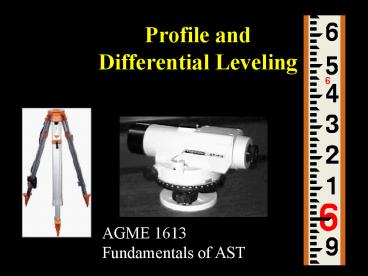Profile and Differential Leveling - PowerPoint PPT Presentation
1 / 47
Title:
Profile and Differential Leveling
Description:
Define differential and profile leveling, and explain the ... attaches level to tripod. ... Tripod and Leveling Rod. Reading the Leveling Rod. Feet. Tenths ... – PowerPoint PPT presentation
Number of Views:1771
Avg rating:3.0/5.0
Title: Profile and Differential Leveling
1
Profile and Differential Leveling
AGME 1613Fundamentals of AST
2
Objectives
- Define differential and profile leveling, and
explain the purpose(s) and agricultural
applications of each. - Identify and correctly set-up and use leveling
equipment. - Properly record leveling field notes and perform
error checks for differential and profile
leveling surveys. - Complete differential and profile leveling
surveys.
3
Leveling Definition and Types
- A surveying procedure used to determine the
elevation of points on the Earths surface. - Differential Leveling
- Profile Leveling
4
Differential Leveling
Purpose is to determine the difference in
elevation between two (or more) points on the
Earths surface.
5
Where is Differential Leveling Used?
- Determining field slope (conservation plans, soil
loss prediction, etc.). - Laying out and checking drainage ditches,
waterways, tile drainage systems, etc. - Cut-and-fill requirements for building
foundations. - Establish new benchmarks that have elevations
tied in with existing benchmarks.
6
Profile Leveling
Purpose is to describe the elevation at selected
points on the Earths surface.
7
Where is Profile Leveling Used?
- Developing field contour maps.
- Designing and checking grade for drainage ditches
and waterways. - Laying out farm ponds.
- Road and highway construction.
8
Leveling EquipmentThe Engineers Level
- Telescope with crosshairs.
- Base plate attaches level to tripod.
- Leveling screws allows user to establish a
level line of sight. - Level bubble Instrument is level when bubble is
inside target. - Focusing knob
9
Leveling Equipment Tripod and Leveling Rod
10
Reading the Leveling Rod
11
(No Transcript)
12
Reading the Leveling Rod
Feet 6
Tenths .0
Hundredths .09
Reading 6.09 ft.
13
Reading the Leveling Rod
3
14
Direct Differential Leveling
What is the difference in elevation between two
points,
Where both points can be shot from the same
location?
6.45
15
Direct Differential Leveling
3.21
B
A
16
Direct Differential Leveling
- Difference in Elevation
- Rod reading at A 6.45
- Rod reading at B 3.21
Difference in elevation
3.24-ft
Which point is higher, A or B?
17
Leveling Terms
- Station (STA)
- Benchmark (BM)
- Backsight (BS)
- Height of Instrument (HI)
- Foresight (FS)
- Elevation (ELEV)
18
Leveling Terms
- Station (STA)
- Point where the rod is placed for a reading
- Stations typically use a distance-numbering
identification system - STA 0 00 0 hundred feet 0 feet
- STA 2 75 two hundred feet 75 feet
- STA 5 05 ?????????
19
Leveling Terms
- Backsight
- A rod reading taken on a point of known
elevation - BM
- TBM
- Turning Point (TP)
20
Leveling Terms
- Benchmark (BM)
- A point of known elevation used as a reference
point in a leveling survey. - A BM has a precisely known elevation above mean
sea level. - Established by a variety of government agencies.
- Temporary Benchmark (TBM) Point of assumed
elevation. Commonly used in on-farm, local
surveys.
21
Leveling Terms
- Height of Instrument (HI)
- Height (elevation) of the levels line of sight.
- HI BS Known Elevation
22
Determining HI
HI 100.00 ft 4.35 ft 104.35 ft
4.35
HI Elev BS
BM-1
Elev 100.00 ft.
23
Leveling Terms
- Foresight (FS)
- Rod reading taken on a point of unknown elevation
- HI FS Elev
24
Determining Elevation
HI 104.35 ft
6.35
Elev HI - FS
Elev 104.35 ft. 6.35 ft. 98.00 ft.
25
Leveling Terms
- Elevation (ELEV)
- Vertical distance above mean sea level of a
point on the earths surface. - Depending on purpose of survey, may be determined
to nearest - .1 ft
- .01 ft.
- .001 ft.
26
Differential Leveling Field Notes
STA BS HI FS ELEV Dist.
27
Differential Leveling
3.21
TBM-1
BM-1
Elev 1225.50 ft.
28
Differential Leveling
3.01
TBM-1
BM-1
TP-1
29
Differential Leveling
6.04
TBM-1
BM-1
TP-1
30
Differential Leveling
0.28
TBM-1
BM-1
31
Differential Leveling
6.45
TBM-1
BM-1
32
Differential Leveling
10.98
TBM-1
BM-1
TP-2
33
Differential Leveling
3.95
TBM-1
BM-1
TP-2
34
Differential Leveling
5.36
TBM-1
BM-1
TP-2
35
Error of Closure
- Difference in the beginning and ending
elevation of a known point. - All surveys will have error.
- The question is, How much error can we tolerate
in our survey?
36
Error Check
- Mathematical Error Check
- Error of closure SBS - SFS
- Allowable Error Check
- Depends on purpose of the survey
- Maximum feet of error based on distance
37
Profile Leveling Field Notes
STA BS HI FS ELEV
38
Simulated Profile Survey
(Elev 100.00)
TBM-A
39
STA. 000
40
STA. 100
41
STA. 135
42
STA. 200
43
STA. 200
44
STA. 275
45
STA. 295
46
STA. 295
47
(No Transcript)































